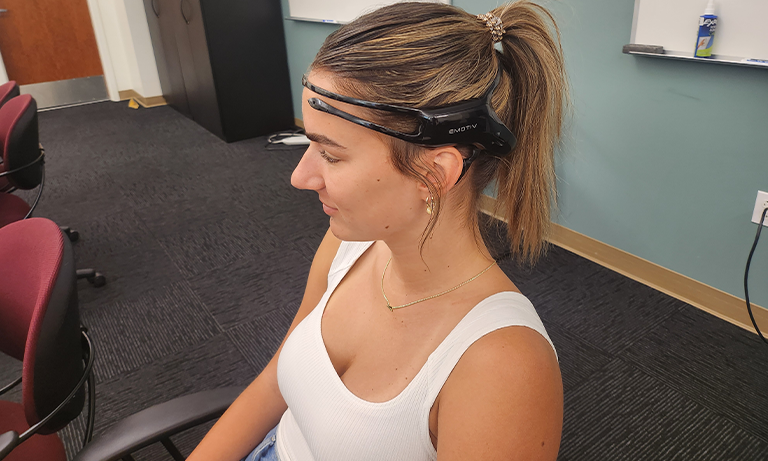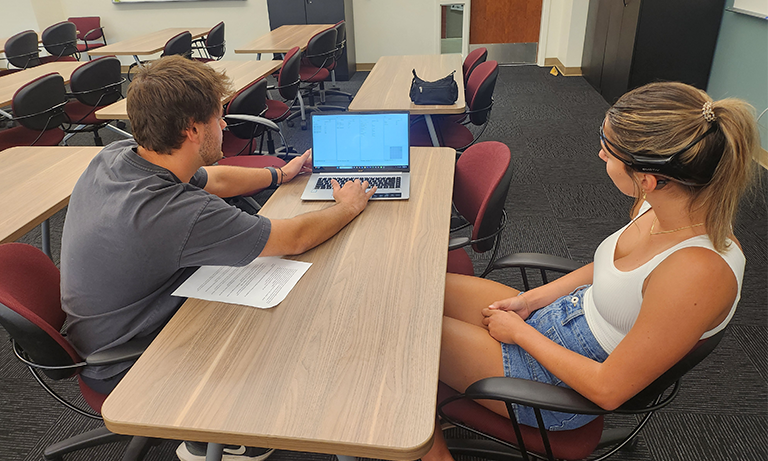As artificial intelligence works its way into our lives, it raises questions about the role it plays.
San Luis Obispo local and industrial and manufacturing engineering senior Phillip Semenov is diving into the gray area and researching the emotional response when people interact with AI.
Semenov is part of an interdisciplinary research project for the Summer Undergraduate Research Program that explores human responses in conversations with AI entities. He and his research partner Hayward, California, native Miguel Coronado (computer science) are working under the guidance of professors Duha Ali (industrial and manufacturing engineering), Javier Gonzalez-Sanchez (computer science and software engineering) and Rafael Guerra Silva (Orfalea College of Business).
“We are using a headset that reads brainwaves to compare the emotional differences when humans interact with other humans versus when humans interact with artificial intelligence systems,” Semenov said.
The process begins with a test subject putting on an Emotiv Insight Headset with nodes placed on different parts of the head, with each node measuring electrical activity in the brain. Then, Semenov has a conversation with the test subject – all the while tracking the emotional response emitted through the headset – to get a baseline of how the subject reacts during human-to-human interaction.
“The data we collect comes in the form of numerical values on a scale from zero to one, and each data point tells us how much of each specific emotion the participant is feeling in any given moment,” Semenov said.
The headset measures emotions like excitement, interest, stress, relaxation and focus, to name a few.

Communications student Kate MacPherson is Semenov’s friend and one of the test subjects for the project. During a mock-interview session, MacPherson put on the headset and examined the chart showing her brainwaves as they moved up and down on the laptop screen.
“When the lines on the graph go up, that means her excitement is increasing,” Semenov explained, referencing the program that collects data points every second.
“We all know that humans are complicated beings, but actually seeing what people are feeling on a numerical scale while answering deep questions is in a league of its own,” Semenov said. “Every person has a different scale as to what is ‘normal’ for them, and it’s interesting to see how that scale changes when they think about different aspects of their lives.”
After the human-to-human test was completed, Semenov passed it over to ChatGPT. The program would also ask a range of questions that would elicit similar emotional responses, the difference being that for this portion, the test subject would be interacting with AI rather than another human.
When asked about how humans typically interact with AI bots, Semenov chuckled.
“It’s funny how we can humanize AI by responding to a chat bot like it’s human,” he said. “Sometimes, you forget that you’re talking to a program.”
Despite how humanized AI can be, Semenov’s research shows that people still have higher levels of excitement, stress and focus when talking to humans over AI systems.
“Our end goal with this project is to gain a deeper understanding of how individuals perceive and engage with AI entities on an emotional level,” he said. “The findings hold implications for designing and developing AI systems that aim to foster more emotionally resonant user interactions, ultimately contributing to advancing human-centered AI technology.”
Semenov and his team will present their work at the Summer Undergraduate Research Program Symposium at Cal Poly on October 18.
By Taylor Villanueva


